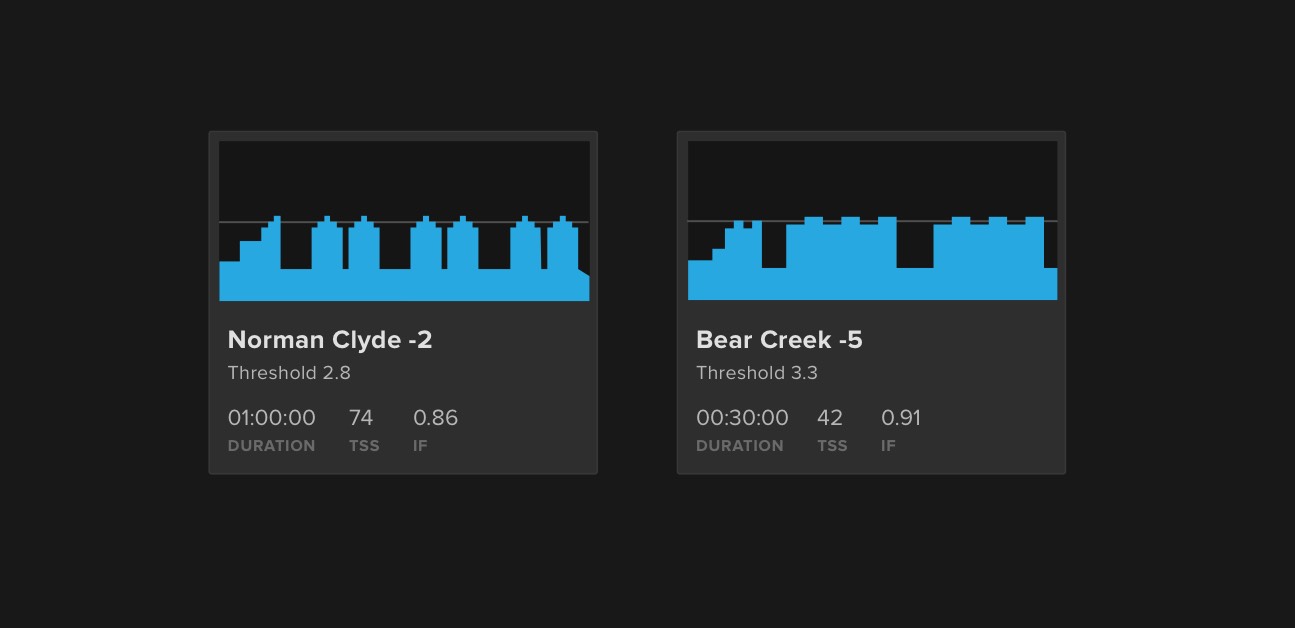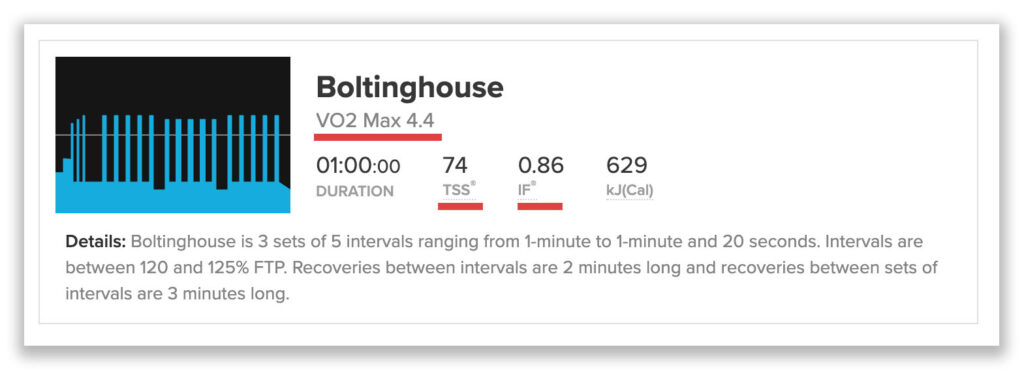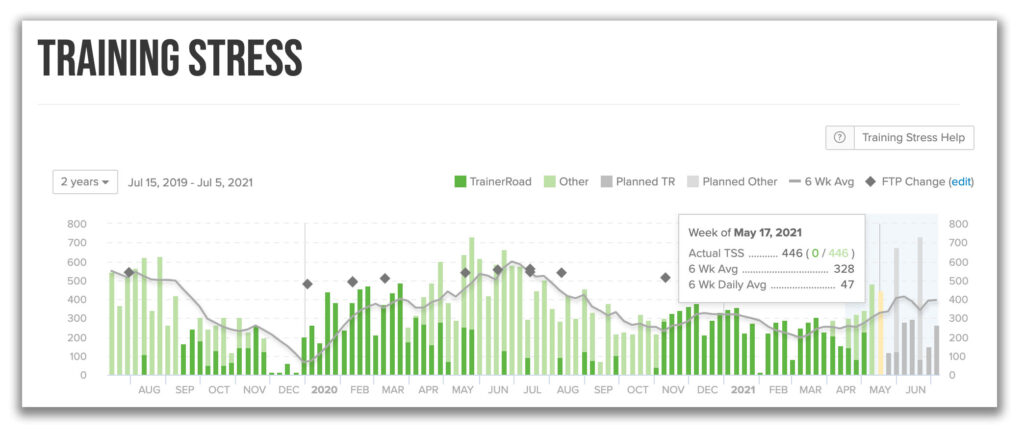TSS, IF, and Workout Levels: 3 Metrics to Help You Understand Your Training And Get Faster

Training Stress Score (TSS), Intensity Factor (IF), and Workout Levels are useful ways to quantify the challenge and effect of a workout. Taken together, these 3 metrics help tell the story of your training, but it’s important to understand the differences of each. What does each metric mean, and how can you use them to get faster?
Abbreviations and Terms used in this article
- FTP – Functional Threshold Power, an approximation of the maximum power you could sustain for an hour
- NP – Normalized Power, a mathematically adjusted measurement of average power that smoothes out power spikes and coasting
- IF – Intensity Factor, a measurement of how intense a workout is, relative to your FTP
- TSS – Training Stress Score, a measurement of the overall training effect of a workout
- Workout Levels – a new metric in TrainerRoad that ranks workouts on a 1-to-10 difficulty scale, compared to other workouts in the same training zone.
3 Metrics, One Concept
TSS, IF, and Workout Levels are 3 different ways of assessing how strenuous and impactful a workout is to complete. Anytime you see a workout in TrainerRoad, you’ll see its Workout Level, TSS, and IF, along with duration and kJ (calories).

Each metric uses a slightly different approach to quantifying stress and challenge, but they all essentially compare your abilities (based on FTP) to the actual work you do in a workout. Since all 3 metrics use Normalized Power (NP) to quantify this work, understanding NP is a useful place to begin.
Normalized Power
Most cyclists are familiar with the concept of power: a real-time measurement of how much energy your legs put into the pedals, expressed in watts. From moment to moment, power is an objective way to know how hard you are riding, but it’s not always as straightforward to interpret when it comes to assessing entire rides.
To understand why, consider an hour of hard sprint repeats vs. an hour of steady endurance riding. The tendency to coast or ride easily between sprints means these very different workouts can result in the same overall average power, but the physical toll of the two workouts is not the same. Sprints are much more fatiguing, but average power doesn’t capture the nuance of how that power is generated.
Normalized Power corrects for this shortcoming. It mathematically weights hard efforts over easy spinning and coasting, for a corrected average power figure that’s truer to the actual experience of a ride. Since it’s a better representation of a ride than a simple average, it’s an important factor in all 3 major metrics we use to judge the difficulty of a ride.

Intensity Factor (IF)
Now that we understand normalized power, we can consider the simplest of the 3 metrics- Intensity Factor (IF).
As its name suggests, Intensity Factor reflects the relative intensity of a workout. To calculate IF, simply divide your workout’s Normalized Power by your FTP. A workout with a normalized power equal to your FTP will have an Intensity Factor of 1.0.
IF can be a useful way to quickly judge a workout’s difficulty. The closer a workout’s Intensity Factor is to 1.0 or above, the more intense it is likely to feel. But there is an important caveat- Intensity Factor measures intensity against your FTP, and your FTP represents the power you can theoretically generate for one hour. IF does not incorporate your power curve or adjust for how your ability to generate power changes over differing durations.
This means short workouts can have Intensity Factors well above 1.0 without actually feeling overly intense, since it’s fairly easy to ride above FTP for short periods. It also means long workouts may be all-out efforts relative to their length but have intensity factors that seem deceptively low, as it’s almost impossible to ride at FTP for much more than an hour. As a result, IF is most clearly insightful for workouts of an hour, and less so for longer or shorter rides.
Adaptive Training
Get the right workout, every time with training that adapts to you.
Check Out TrainerRoadTraining Stress Score (TSS)
Training Stress Score (TSS) is a bit more nuanced, incorporating both intensity and duration. TSS assigns every workout a simple numerical score that approximates how impactful and fatiguing it is on the body. Many athletes use it as a convenient way of tracking their training over time, with average weekly TSS serving as a proxy for changing fitness. But like Intensity Factor, TSS has important caveats and can be misleading if considered out of context.
Let’s look at the calculation for TSS to understand why:
(# of seconds of the workout x Normalized Power x Intensity Factor) / (FTP x 3600) x 100.
This formula means riding at your FTP for an hour results in 100 TSS. It also means that a short, hard ride can result in the same TSS as a long, easy one. Since these rides have very different impacts on your body, the fact that TSS makes no distinction for how training stress is generated can be misleading. A common truism holds that “All TSS is not created equal” and while TSS can be very useful for monitoring trends in your training over time, it’s important to keep its shortcomings in mind. For more on the uses and limitations of TSS, click here.

Workout Levels
Workout Levels are a new way to quantify the relative difficulty of each TrainerRoad workout within its training zone. Workout Levels range from 1 to 10, with 1 being easiest and 10 being hardest. A few exceptional workouts can even exceed 10.
Workout Levels are unique to TrainerRoad and use a formula derived from machine learning, incorporating subjective factors like repetition, interval length, and recovery time. Like TSS and IF, intensity and duration are considered, but unlike other metrics, the actual design of a workout influences its Workout Level.
As an example of why this matters, imagine 2 workouts with the same work intervals but different recovery periods. Both workouts would result in the same Intensity Factor and TSS, but the workout with shorter recoveries would feel harder. Workout Levels detect this difference, and that workout would have a higher level as a result.

Workout Levels are a powerful way of understanding how hard a workout feels in the real world. They’re also a useful way to guide progressions from week to week in a training plan, and they are incorporated into all TrainerRoad plans.
Importantly, Workout levels are only meant to compare workouts within a training zone—for instance, a VO2 max 5.0 workout is harder than a VO2 max 2.0 workout, but can’t be compared to a Threshold 2.0 workout.
A Fuller Picture of Your Training
Individually, no single metric tells the whole story of how your body responds to training. But taken together, TSS, IF, and Workout Levels contribute to a more detailed understanding of your workouts and their impact on your fitness.
IF is very useful for understanding how intense a workout or event is, particularly if it’s around an hour in duration. It can also be useful for contextualizing efforts against your FTP and for developing pacing plans for key events.
TSS is an easy way to estimate how fatiguing a ride may be, and is especially valuable for making sure your training ramps at a sustainable rate. By avoiding major increases in TSS from week to week, you can progressively build fitness while managing fatigue and preventing burnout– just remember the limitations inherent in how TSS is calculated.
Finally, Workout Levels offer the most insightful way to understand how difficult a workout will feel. They’re especially useful when planning training and comparing workouts to others you’ve recently done within the same training zone. By using Levels to pick workouts within a level or so of those you’ve successfully completed, you set yourself up for success and consistency and are less likely to struggle with workouts beyond your ability.
Further Reading
Note: Training Stress Score (TSS), Intensity Factor (IF), Normalized Power (NP), and Functional Threshold Power (FTP) are registered trademark terms owned by TrainingPeaks and are used with permission.
